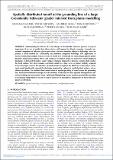Files in this item
Spatially distributed runoff at the grounding line of a large Greenlandic tidewater glacier inferred from plume modelling
Item metadata
| dc.contributor.author | Slater, Donald Alexander | |
| dc.contributor.author | Nienow, Peter | |
| dc.contributor.author | Sole, Andrew | |
| dc.contributor.author | Cowton, Tom | |
| dc.contributor.author | Mottram, Ruth | |
| dc.contributor.author | Langen, Peter | |
| dc.contributor.author | Mair, Douglas | |
| dc.date.accessioned | 2017-02-07T13:30:37Z | |
| dc.date.available | 2017-02-07T13:30:37Z | |
| dc.date.issued | 2017-04 | |
| dc.identifier | 248138426 | |
| dc.identifier | 36592cfe-c9a7-42a6-ba81-290ab035eaa9 | |
| dc.identifier | 85014618765 | |
| dc.identifier | 000396124800008 | |
| dc.identifier.citation | Slater , D A , Nienow , P , Sole , A , Cowton , T , Mottram , R , Langen , P & Mair , D 2017 , ' Spatially distributed runoff at the grounding line of a large Greenlandic tidewater glacier inferred from plume modelling ' , Journal of Glaciology , vol. 63 , no. 238 , pp. 309-323 . https://doi.org/10.1017/jog.2016.139 | en |
| dc.identifier.issn | 0022-1430 | |
| dc.identifier.other | ORCID: /0000-0003-1668-7372/work/60427782 | |
| dc.identifier.other | ORCID: /0000-0001-8394-6149/work/70619151 | |
| dc.identifier.uri | https://hdl.handle.net/10023/10244 | |
| dc.description | DAS is supported by a UK Natural Environmental Research Council PhD studentship. The authors acknowledge NERC Grants NE/K015249/1 and NE/F021399/1 (to PWN), NE/K014609/1 (to AJS) and NE/H024964/1 (to DWFM). The research leading to these results has also received funding (to RHM and PLL) from the European Research Council under the European Community's Seventh Framework Programme (FP7/2007-2013) / ERC grant agreement 610055 as part of the ice2ice project. Data from the Programme for Monitoring of the Greenland Ice Sheet (PROMICE) were provided by the Geological Survey of Denmark and Greenland (GEUS) at http://www.promice.dk. | en |
| dc.description.abstract | Understanding the drivers of recent change at Greenlandic tidewater glaciers is of great importance if we are to predict how these glaciers will respond to climatic warming. A poorly constrained component of tidewater glacier processes is the near-terminus subglacial hydrology. Here we present a novel method for constraining near-terminus subglacial hydrology with application to marine-terminating Kangiata Nunata Sermia in south- west Greenland. By simulating proglacial plume dynamics using buoyant plume theory and a general circulation model, we assess the critical subglacial discharge, if delivered through a single compact channel, required to generate a plume which reaches the fjord surface. We then compare catchment runoff to a time series of plume visibility acquired from a time-lapse camera. We identify extended periods throughout the 2009 melt season where catchment runoff significantly exceeds the discharge required for a plume to reach the fjord surface, yet we observe no plume. We attribute these observations to spatial spreading of runoff across the grounding line. Persistent distributed drainage near the terminus would lead to more spatially homogeneous submarine melting and may promote more rapid basal sliding during warmer summers, potentially providing a mechanism independent of ocean forcing for increases in atmospheric temperature to drive tidewater glacier acceleration. | |
| dc.format.extent | 15 | |
| dc.format.extent | 1600821 | |
| dc.language.iso | eng | |
| dc.relation.ispartof | Journal of Glaciology | en |
| dc.subject | Glacier hydrology | en |
| dc.subject | Ice/ocean interactions | en |
| dc.subject | Subglacial processes | en |
| dc.subject | GE Environmental Sciences | en |
| dc.subject | 3rd-DAS | en |
| dc.subject | SDG 14 - Life Below Water | en |
| dc.subject.lcc | GE | en |
| dc.title | Spatially distributed runoff at the grounding line of a large Greenlandic tidewater glacier inferred from plume modelling | en |
| dc.type | Journal article | en |
| dc.contributor.institution | University of St Andrews. School of Geography & Sustainable Development | en |
| dc.contributor.institution | University of St Andrews. Geography & Sustainable Development | en |
| dc.contributor.institution | University of St Andrews. Bell-Edwards Geographic Data Institute | en |
| dc.identifier.doi | https://doi.org/10.1017/jog.2016.139 | |
| dc.description.status | Peer reviewed | en |
This item appears in the following Collection(s)
Items in the St Andrews Research Repository are protected by copyright, with all rights reserved, unless otherwise indicated.

